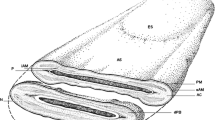Summary
In the present study the development of the bovine acrosome was investigated using conventional electron-microscopical techniques as well as the phosphotungstic-acid (PTA) technique (Rambourg 1967) including enzymatic digestion experiments. As in other species and in accordance with previous light-microscopical studies (Clermont and Leblond 1955) four phases of acrosomal differentiation can be discerned: the Golgi-phase, cap-phase, acrosome-phase, and maturation-phase.
In the bull no internal pattern of the acrosomal content can be observed, either with conventional uranyl acetate-lead citrate staining or with the PTA-techniques. Our results support the observation in other species (Fawcett et al. 1971) that no intrinsic polymerization or crystallization process of the acrosomal content is responsible for acrosomal shaping. Some of our results suggest the influence of external forces on acrosomal development in the bull. During the cap-phase and the acrosome-phase accumulations of smooth endoplasmic reticulum and a layer of fine filaments can be observed in the Sertoli-cell cytoplasm, immediately adjacent to the developing acrosome. A temporary influence of these structures on acrosomal development seems possible. The PTA-positive staining of the developing bovine acrosome is probably due to the presence of acrosomal glycoproteins; however, our results do not exclude the possibility that molecules other than glycoproteins contribute to the positive PTA-staining of the developing acrosome.
Similar content being viewed by others
References
Blom E, Birch-Andersen A (1965) The ultrastructure of the sperm head. Nord Vet Med 17:193–212
Bryan JHD (1977) Spermatogenesis revisited. III The course of spermatogenesis in a male sterile pink-eyed mutant type in the mouse. Cell Tissue Res 180:173–186
Clermont Y, Leblond CP (1955) Spermiogenesis of man, monkey, ram and other mammals as shown by the periodic acid Schiff technique. Am J Anat 96:229–250
Courtens JL (1978) Cytochemical localization of glycoproteins in the developing acrosome of ram spermatids. J Ultrastr Res 65:173–181
Courtens JL, Courot M (1980) Acrosomal and nuclear morphogenesis in ram spermatids: An experimental study of hypophysectomized and testosterone supplemented animals. Anat Rec 197:143–152
Fawcett DW (1975) Ultrastructure and function of the Sertoli cell. In: Handbook of Physiology, Section 7, Endocrinology V. American Physiological Society, Washington, pp 21–55
Fawcett DW, Anderson WA, Phillips DM (1971) Morphogenetic factors influencing the shape of the sperm head. Dev Biol 26:220–251
Flechon JE (1974) Validity of phosphotungstic acid staining of polysaccharide (glycogen) at very low pH on thin sections of glycolmethacrylate embedded material. J Microsc 19:207–214
Flechon JE (1976) Heterogeneous distribution of glycoproteins in the acrosome of boar, bull, ram and rabbit spermatozoa. 8th Intern Congr Anim Reprod Art Insem, Krakow, pp 892–895
Flechon JE (1979) Sperm glycoproteins of the boar, bull, rabbit and ram. I. Acrosomal glycoproteins. Gamete Res 2:43–51
Geyer G (1977) In: Handbuch der Histochemie, Band 1, Teil 3. Fischer, Stuttgart New York, pp 12–17
Glick D, Scott JE (1970) Phosphotungstic-acid not a stain for polysaccharide. J Histochem Cytochem 18:455
Hartree EF (1975) The acrosome-lysosome relationship. J Reprod Fertil 44:125–126
Hartree EF (1977) Spermatozoa, eggs and proteinases. Biochem Soc Trans 5:375–394
Holstein AF (1976) Ultrastructural observation on the differentiation of spermatids in man. Andrologia 8:157–165
Holstein AF, Schirren C (1979) Classification of abnormalities in human spermatids based on recent advances in ultrastructure research on spermatid differentiation. In: The Spermatozoon. Urban u Schwarzenberg Inc, Baltimore Munich, pp 341–353
Holt WV (1979) Development and maturation of the mammalian acrosome. A cytochemical study using phosphotungstic acid staining. J Ultrastr Res 68:58–71
Leblond CP, Clermont Y (1952) Spermiogenesis of rat, mouse, hamster and guinea pig as revealed by the “periodic acid fuchsin sulfurous acid technique”. Am J Anat 90:167–216
Leduc EH, Bernhard WJ (1967) Recent modifications of the glycol-methacrylate embedding procedure. J Ultrastr Res 19:196–199
Lengfelder KD (1978) Elektronenmikroskopische Untersuchungen zur Differenzierung männlicher Keimzellen des Rindes. Inaug Diss München
Lorton SP, First NL (1979) Hyaluronidase does not disperse cumulus oophorus surrounding bovine ova. Biol Reprod 21:301–308
McRorie RA, William WL (1974) Biochemistry of mammalian fertilization. Ann Rev Biochem 43:777–803
Nicander L, Bane A (1966) Fine structure of the sperm head in some mammals with particular reference to the acrosome and subacrosomal substance. Z Zellforsch 72:496–515
O'Donnell JM, Symons DBA, Wooding FBP (1970) Immunofluorescence and electron microscopy of acrosomes of bull spermatozoa. J Physiol (Lond) 210:120–123
Quintarelli G, Zito R, Cifonelli JA (1971a) On phosphotungstic acid staining I. J Histochem Cytochem 19:641–647
Quintarelli G, Cifonelli JA, Zito R (1971b) On phosphotungstic acid staining II. J Histochem Cytochem 19:648–653
Rambourg A (1967) Détection de glycoprotéines en microscopic électronique: coloration de la surface cellulaire et de l'appareil de Golgi par un mélange acide chromique-phosphotungstique. C R Acad Sc Paris 265:1426–1428
Reynolds ES (1963) The use of lead citrate at high pH as an electron-opaque stain in electron microscopy. J Cell Biol 17:209–212
Saake RG, Almquist JO (1964) Ultrastructure of bovine spermatozoa. I. The head of normal, ejaculated sperm. Am J Anat 115:143–161
Sandoz D (1970) Evolution des ultrastructures au cours de la formation de l'acrosome des spermatozoides de la souris. J Microsc 9:535–558
Scott JE (1971) Phosphotungstate: an “universal” (nonspecific) precipitant for polar polymers on acid solution. J Histochem Cytochem 19:689–695
Scott JE, Glick D (1971) The invalidity of “phosphotungstic acid as a specific electron stain for complex carbohydrates”. J Histochem Cytochem 19:63–64
Susi FR, Clermont Y, Leblond CP (1971) Changes in the Golgi-apparatus during spermiogenesis in the rat. Am J Anat 130:251–268
Wooding FBP, O'Donnell JM (1971) A detailed ultrastructural study of the head membranes of ejaculated bovine sperms. J Ultrastr Res 35:71–85
Wrobel KH, Mademann R, Sinowatz F (1979) The lamina propria of the bovine seminiferous tubule. Cell Tissue Res 202:357–377
Author information
Authors and Affiliations
Additional information
Supported by a grant from the Deutsche Forschungsgemeinschaft
Rights and permissions
About this article
Cite this article
Sinowatz, F., Wrobel, KH. Development of the bovine acrosome. Cell Tissue Res. 219, 511–524 (1981). https://doi.org/10.1007/BF00209990
Accepted:
Issue Date:
DOI: https://doi.org/10.1007/BF00209990




